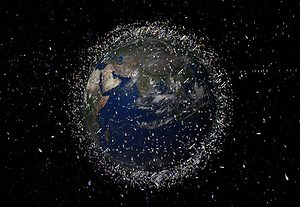Ever increasing CO2 levels in the atmosphere are not only hazardous to life on the planet’s surface, but also to human operations in space. A new study has found that an increase in carbon dioxide in the atmosphere upper levels could push made-made objects orbiting the planet further away from their trajectories, resulting in a faster accumulation of space junk and an increase risk of collusion with valuable satellites.
Carbon dioxide warms the lower atmosphere of Earth, however it works as a coolant at higher altitudes, where it’s not dense enough to recapture the heat that it emits. Thus, in its upper most layers the same build-up causes a cooling effect. So, the thermosphere, the upper-most layer of the atmosphere, begins to contract and in the process reduces the drag effect on satellites, the International Space Station, as well as any other object orbiting this region.
“The observed CO2 increase is expected to gradually result in a cooler, more contracted upper atmosphere and a consequent reduction in the atmospheric drag experienced by satellites,” said a statement from the Naval Research Laboratory, which took part in the study.
This translates in a longer life span for space junk, as more such objects will stay farther out for longer instead of burning up in the lower layers of the atmosphere, closer to Earth. Space debris already consist a very serious issue for operations in space, as hundreds of thousands of space junk debris travel at huge speeds in sub-orbital space, posing a high risk to satellites and manned missions at the International Space Station. A number of solutions have been proposed in order to deal with the issue, however deployment is still far away from becoming reality.
“Consequently, space junk will accumulate at a faster rate and we will see more collisions between space objects as a result,” the report stated. “We will also see many more ‘near-misses’ and these have an important effect on spacecraft operators.”
The scientists estimate that the concentration of carbon near 100 km altitude is increasing at a rate of 23.5 ± 6.3 parts per million per decade – about 10 ppm/decade faster than predicted by upper atmospheric model simulations. On the bright side, the scientists involved in the Atmospheric Chemistry Experiment (ACE), a scientific satellite mission funded primarily by the Canadian Space Agency, claim that the thermosphere contraction means that satellites won’t have to commence re-orbiting operations so often, saving fuel in the process.
Findings were reported in the journal Nature Geoscience.










